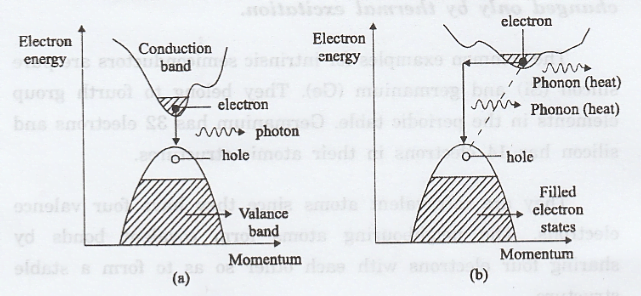Direct vs Indirect Bandgap Semiconductors – Definition, Differences, Examples & Applications
Electrons from the valence band can be excited to the conduction band by either thermal excitation or by optical absorption. When the electron returns to the valence band, the energy is released either as heat or as photons.
- In direct band gap semiconductors, the dominant mechanism by which the energy is released in the form of photons(electromagnetic radiation), while in indirect band gap semiconductors the energy is released in the form of phonons (heat).
- In a direct band gap semiconductor, the top of the valence band and the bottom of the conduction band have the same momentum value. In an indirect band gap semiconductor, the maximum energy of the valence band occurs at a different momentum value
- Direct band gap semiconductors are used in light-emitting applications like LEDs and lasers. Eg: GaAs, InAs, GaN and InGaAs.
- Indirect band gap semiconductors are used in manufacturing chips like Intel processor. Eg: Silicon.

MCQs on Direct vs Indirect Bandgap Semiconductors
-
In a direct bandgap semiconductor, the conduction band minimum (CBM) and valence band maximum (VBM) occur:
<
- a) At different k-values
- b) At the same k-value
- c) Randomly
- d) None of these
Answer
b) At the same k-value
-
Which of the following is a direct bandgap semiconductor?
- a) Silicon (Si)
- b) Germanium (Ge)
- c) Gallium Arsenide (GaAs)
- d) Diamond (C)
Answer
c) Gallium Arsenide (GaAs)
-
Indirect bandgap semiconductors require ______ for electron transition between bands.
- a) A photon
- b) A phonon
- c) A neutron
- d) A positron
Answer
b) A phonon
-
Which application typically uses direct bandgap semiconductors?
- a) LEDs and Lasers
- b) Microprocessors
- c) Power rectifiers
- d) Transistors only
Answer
a) LEDs and Lasers
-
Why is silicon not suitable for light-emitting applications?
- a) It has a large bandgap
- b) It is an indirect bandgap semiconductor
- c) It cannot conduct electricity
- d) It is too expensive
Answer
b) It is an indirect bandgap semiconductor